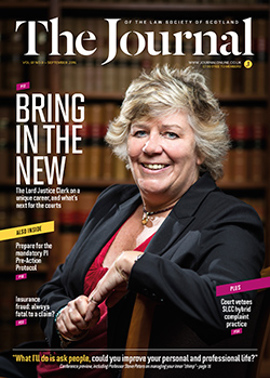Good claims, bad lies

While there have always been fraudulent claims in Scotland, they are becoming more prolific. In a jurisdiction with a relatively advantageous expenses regime and a current tolerance for referral fees, Scotland is now fertile ground for those looking to pursue fraudulent claims.
With insurers taking a firmer stance on fraud in Scotland, it is only a matter of time before these issues are considered more frequently in the Scottish courts. In Scotland we do not have the benefit of legislative provisions such as “fundamental dishonesty” (a concept that appears in s 57 of the Criminal Justice and Courts Act 2015 and in the Civil Procedure Rules in England & Wales), nor a vast catalogue of judicial commentary. We therefore look to the approach being taken to such matters by the bench in England & Wales for some assistance. With this in mind, it is important that we consider the potential impact of the two most recent Supreme Court decisions in this area.
Hayward v Zurich Insurance Co plc [2016] UKSC 48
Colin Hayward suffered an injury at work in June 1998. Proceedings were brought and liability was admitted. During the course of the claim, Zurich began to suspect that Hayward had deliberately and dishonestly exaggerated the extent of his injuries in order to obtain a higher settlement. The claim was settled at £134,973. At the time of the settlement in October 2003, Zurich had video evidence of the exaggeration.
In February 2009, having obtained further evidence showing that Hayward had in fact fully recovered a year before the settlement, Zurich sought to set aside the settlement and claimed damages for deceit. Following appeals from Hayward and then Zurich, the Supreme Court ultimately allowed Zurich’s appeal, overturning the Court of Appeal conclusion that the settlement agreement could not be set aside, and reinstated the decision of the High Court that Hayward should be awarded only the reduced sum of £14,720 and ordered to repay the difference.
The appeal clarifies three important questions regarding fraudulent misrepresentation:
1) Must the insurer prove that it was induced into settlement because it believed the misrepresentations were true? No.
2) Is it sufficient to establish that the misrepresentations were a material cause of the insurer entering into settlement? Yes.
3) Is the insurer precluded from attempting to set aside a settlement because it suspected exaggeration for financial gain at the time the settlement was entered into? No.
Impact in Scotland?
The route to achieving the same outcome would differ in Scotland, as the insurer would either have to reduce the contract, and then under the law of unjustified enrichment recover monies paid, or, alternatively, it would have to sue in delict. To succeed, the insurer would have to prove that it was induced into the agreement by the fraudulent misrepresentation. Ultimately, the judiciary would have to consider the same three questions above.
It is to be hoped that this decision will give fraudulent pursuers pause for thought before perpetrating the fraud. It is noticeable here that the part of the claim which was not fraudulent (i.e. the injury claim worth £14,720) was permitted to proceed. This strong stance against fraud is, however, slightly diluted by the decision in Versloot, which concerns first party fraud, rather than third party fraud (as had been the case
in Hayward).
Versloot Dredging BV v HDI Gerling Industrie Versicherung AG [2016] UKSC 45
In January 2010, a ship, the DC Merwestone, was damaged beyond repair by seawater ingress to the engine room. The claimant vessel owner made a claim under a marine insurance policy it held with the defendant insurer.
Frustrated that the insurers were not paying up, and hoping to prevent a lengthy investigation into whether the ship was seaworthy (as there was no cover if the vessel owners had sent the vessel out in an unseaworthy condition), the claimant told the defendant that the bilge alarm had sounded but that the crew had been unable to react because of rough seas. That was not true. It subsequently transpired at trial that the vessel was seaworthy and the loss was caused by perils at sea. The lie by the insured ultimately made no difference to the underlying substantive merits of the insurance claim.
On 20 July 2016, the Supreme Court handed down its judgment, dispelling the assumption that the deployment of a “fraudulent device” by the insured in the course of an insurance claim entitles the insurer to decline the entire claim. This is the first time that the Supreme Court has had the opportunity to resolve the question of whether the fraudulent claims rule applies to justified claims but which are supported by a “collateral lie”.
The court distinguished:
1) an entirely fabricated claim;
2) an exaggeration to an otherwise genuine claim;
3) collateral lies, immaterial and irrelevant, to an otherwise genuine claim.
The fraudulent claims rule, i.e. the right of the insurer to forfeit the entire claim, was upheld in respect of (1) and (2) but not (3). It followed that, notwithstanding the lie by the claimant, the claim could not be forfeited by its insurer.
The fraudulent claims rule has been a fundamental principle of first party insurance law across the UK. Decisions in recent years have assumed that the same rule applies, in effect, to “fraudulent devices”. A fraudulent device is a dishonest lie told in support of an honest claim, usually to enhance the prospects of a claim being met, to speed up payment of the claim or to obtain payment with less hassle. In essence, even if the underlying event giving rise to the insurance claim is genuine, the insurer was, under common law, thought to be permitted to decline the claim because (for example) the insured might have submitted a forged invoice or dishonestly embellished the facts.
The decision is bound to raise concerns for the insurance industry. It perhaps takes another step towards levelling the playing field between insurer and insured, similar to the impact of the Insurance Act 2015 and the Enterprise Act 2016.
Impact in Scotland?
As relatively few insurance fraud cases are litigated in Scotland, it will be interesting to see how the Versloot rule will be applied by the Scottish courts as a refinement to the requirement of the utmost good faith. The distinction between Hayward and Versloot is that Hayward involved a fraudulent attempt to increase the value of a genuine claim, whereas in Versloot the fraud was collateral to the claim. Perhaps this case indicates that a wee white lie is acceptable if your neighbours don’t find out.
In this issue
- Beyond the named person service
- Sexual harassment: an everyday problem
- Governing Scotland in a federal United Kingdom
- Losing our judgment? (1)
- Reading for pleasure
- Opinion: Alison Reid
- Book reviews
- Profile
- President's column
- The future, step by step
- People on the move
- Changing face of the courts
- Success: the chimp factor
- Courts reform: a call to pre-action
- Teeth that could be sharper
- Good claims, bad lies
- Unlocking doors: demystifying squatting
- Back to basics
- Brexit and IP: what should solicitors be doing now?
- Agency, insolvency and termination
- Brexit and the agricultural sector
- A carnival for some, but not for others
- Scottish Solicitors' Discipline Tribunal
- Culling of the hybrids
- Common property: what policy?
- Cause of action
- Client balances: reminder issued
- Law reform roundup
- From the Brussels office
- Paralegal pointers
- Your Law Society of Scotland Council Members
- At the doors of the court
- Ask Ash
- To the focused, the medals
- Losing our judgment?
- MacKenzie boosts Society's AML drive






